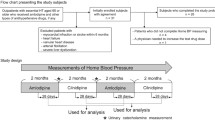Abstract
The acute hemodynamic effects of 20 mg iv amlodipine were evaluated in a placebo-controlled study in 16 normotensive patients 15 ± 1 days after an acute myocardial infarction by covariance analysis. Atenolol was given orally for at least 1 week before the study to maintain the heart rate between 50 and 60 beats/min. All patients were given two doses of 10 mg of amlodipine, or 10 ml of a placebo twice, in iv infusion lasting 2 minutes each. Hemodynamic data were collected during the control period and 15 minutes after each of the two amlodipine or placebo infusions. At the time of the last measurements, 15 minutes after the second amlodipine or placebo infusion, the plasma amlodipine level was 31 ± 16 μg/l and the plasma atenolol level was 773 ± 564 μ/l in the amlodipine group versus 795 ± 916 μg/l in the placebo group. There were no chronotropic, dromotropic, or inotropic effects. The main hemodynamic effect was a fall in systemic vascular resistance (1548 ± 591 dynes.sec.cm-5to 1176 ± 526 dynes.sec.cm-5, p = 0.045) with decreases in aortic pressure and in the left ventricular stroke work index. The left ventricular ejection fraction was 51 ± 12% in the placebo group and 56 ± 15% in the amlodipine group (ns) during the control period, and did not change after infusion of placebo or amlodipine. Left ventricular compliance seemed to be enhanced by amlodipine, because the end-diastolic left ventricular volume index rose from 82 ± 11 ml/m2 to 87 ± 11 ml/m2 (p = 0.026) 15 minutes after the beginning of the second infusion of 10 mg of amlodipine, without any change in end-diastolic left ventricular pressure. Intravenous infusion of 20 mg of amlodipine is well tolerated 15 days after acute myocardial infarction in normotensive patients without deeply depressed left ventricular systolic function and chronically treated with atenolol. The main hemodynamic effects observed are potentially useful for such patients.
Similar content being viewed by others
References
Burges RA, Dodd MG. Amlodipine: Cardiovasc Drug Rev 1990;8:25–44.
DiBianco R, Schoomaker FV, Singh JB, et al. Amlodipine combined with beta-blockade for chronic angina: Results of a multicenter, placebo-controled randomized double-blind study. Clin Cardiol 1992;15:519–524.
Hogg KJ, Hornung RS, Hillis WS, Gupta S, Grant P, Singh SP. Pharmacodynamics of amlodipine: Hemodynamic effects and antianginal efficacy after atrial pacing. Am Heart J 1989;118:1107–1113.
Robson RH, Wishwanath MC. Nifedipine and β-blockade as a cause of cardiac failure. Br Med J 1982;294:104
Opie LH, White DA. Adverse interaction between nifedipine and beta blockade. Br Med J 1980;281:1402.
Leon MB, Rosing DR, Bonow RO, Epstein SE. Combination therapy with calcium-channel blockers and beta blockers for chronic stable angina pectoris. Am J Cardiol 1985;55:69B–80B.
Rocha P, Zannier D, Baron B, Pathé M, David D, Kahn JC. Acute hemodynamic effects of intravenous nicardipine in patients treated chronically with propanolol for coronary disease. Am J Cardiol 1987;59:775–781.
Kloner RA, Hale SL, Alker KJ. Absence of hemodynamic deterioration in the presence of amlodipine following experimental myocardial infarction. J Cardiovasc Pharmacol 1992;20:837–845.
Haggar JM, Newman LG, Kloner RA. Effects of amlodipine on myocardial infarction, infarction expansion, and ventricular geometry in the rat. Am Heart J 1992;124:571–580.
Dodge HT. Determination of left ventricular volume and mass. Radiol Clin North Am 1971;9:459–467.
Grunk-Emeyer GL, Burg BA, Anderson RP. A simple method for calculating Vmax (abstr). Clin Res 1973;31:422.
Thomas SHL, Cooper RC, Ekwuru M et al. Differential cardiovascular effects of propranolol, atenolol, and pindolol measured by impedance cardiography. Eur J Clin Pharmacol 1992;42:47–53.
McAinsh. Clinical pharmacokinetics of atenolol. Postgrad Med J 1977;53(Suppl 3):74–78.
Faulkner JK, McGibney D, Chasseaud LF, Perry JL, Taylor IW. The pharmacokinetics of amlodipine in healthy volunteers after single intravenous and oral doses and after 14 repeated oral doses given once daily. Br J Clin Pharmacol 1986;22:21–25.
Abernethy DR. An overview of pharmacokinetics and pharmacodynamics of amlodipine in elderly persons with systemic hypertension. Am J Cardiol 1994;73:10A–17A.
Packer M, Meller J, Medina N, et al. Hemodynamic consequences of combined β adrenergic and slow calcium-channel blockade in man. Circulation 1982;65:660–668.
Paker G, Danheshmed TK, Roberts JC. Do beta blockers differ in their effects on hepatic microsomal enzymes and liver blood flow? J Clin Pharmacol 1984;24:493–499.
Hillon P, Lebrec D, Munoz C, Jungers M, Goldfarb G, Benhamou JP. Comparison of the effects of a cardioselective and a nonselective β-blocker on portal hypertension in patients with cirrhosis. Hepatology 1982;5:528–531.
Rocha P, Guerret M, David D, Marchand X, Kahn JC. Kineties and hemodynamic effects of intravenous nicardipine modified by previous propranolol oral treatment. Cardiovasc Drugs Ther 1990;4:1525–1532.
Nayler WG. The effect of amlodipine on hypertension-induced cardiac hypertrophy, and reperfusion-induced calcium overload. J Cardiovasc Pharmacol 1988;12(Suppl 7):S41–S44.
Van den Berg EK, Dehmer GJ. Acute hemodynamic effects of intravenous isradipine. Am J Cardiol 1988;61:1102–1105.
Schwinger RHG, Bohm M, Erdmann E. Negative inotropic properties of isradipine, nifadipine, diltiazem, and verapamil in diseased human myocardial tissue. J Cardiovasc Pharmacol 1990;15:892–899.
Vetrovec GW, Plumb V, Epstein AE, Kay GN. Evaluation of the acute hemodynamic and electrophysiologic effects of amlodipine alone and in combination with a β-blocker in patients with angina pectoris. J Cardiovasc Pharmacol 1993;22(suppl A):S29–S33.
Dodd MG, Gardiner DG, Carter AJ, Sutton MR, Burges RA. The hemodynamic properties of amlodipine in anaesthetized and conscious dogs: Comparison with nitrendipine and the influence of β-adrenergic blockade. Cardiovasc Drugs Ther 1989;3:545–555.
Dunlap ED, Plowden JS, Lathrop DA, Millard RW. Hemodynamic and electrophysiologic effects of amlodipine, a new calcium channel blocker. Am J Cardiol 1989;64:171–177.
Lucchesi BR, Tamura Y. Cardioprotective effects of amlodipine in the ischemic reperfused heart. Am Heart J 1989;118:1121–1122.
Author information
Authors and Affiliations
Rights and permissions
About this article
Cite this article
Rocha, P., Pathé, M., Bernaud, C. et al. Acute Hemodynamic Effects of Amlodipine 15 Days After a Myocardial Infarction in Normotensive Patients Treated with Atenolol. Cardiovasc Drugs Ther 11, 139–147 (1997). https://doi.org/10.1023/A:1007732830753
Issue Date:
DOI: https://doi.org/10.1023/A:1007732830753




